Transparent blurry view which blurs layout underneath
Blurring in real time on android is still a hurdle. Here's a comprehensive comparison between some of the viable mechanisms:
StackBlur (already listed in the answer by
Onurunder the monikerfastBlur):
How it looks (at radius 20):
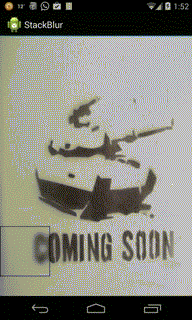
Logged time(ms) to generate each BitmapDrawable:
I/(10266): Total time taken: 35
I/(10266): Total time taken: 54
I/(10266): Total time taken: 48
I/(10266): Total time taken: 36
I/(10266): Total time taken: 48
I/(10266): Total time taken: 39
I/(10266): Total time taken: 49
I/(10266): Total time taken: 50
I/(10266): Total time taken: 35
I/(10266): Total time taken: 47
Average => ~ 44.1 ms => 22 drawables per second
RenderScript:
ScriptIntrinsicBlur provides a consistently fast blur. Its available api 8 onwards using the support library.
What it looks like (at radius 20):
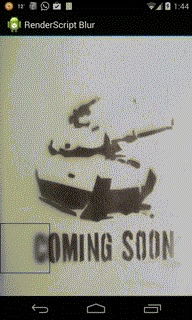
Logged time(ms) to generate each BitmapDrawable:
I/(9342): Total time taken: 14
I/(9342): Total time taken: 16
I/(9342): Total time taken: 13
I/(9342): Total time taken: 28
I/(9342): Total time taken: 14
I/(9342): Total time taken: 12
I/(9342): Total time taken: 14
I/(9342): Total time taken: 19
I/(9342): Total time taken: 13
I/(9342): Total time taken: 13
Average => ~ 15.6 ms => 64 drawables per second
RenderScript (radius = 3) + Scaling (20%):
This is another way of getting a decent(?) but fast blur. What we do is scale the bitmap to a fraction of its size - say 20% - and apply the blur algorithm on the scaled down version. Once that is done, we scale the bitmap to its original size. Results are not as good as using the blur algorithm on the original, but they are passable. Also notice that the radius value shouldn't be too high or the resulting bitmap will be indiscernible.
What it looks like:
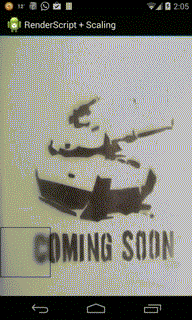
Logged time(ms) to generate each BitmapDrawable:
I/(11631): Total time taken: 5
I/(11631): Total time taken: 19
I/(11631): Total time taken: 3
I/(11631): Total time taken: 7
I/(11631): Total time taken: 7
I/(11631): Total time taken: 5
I/(11631): Total time taken: 7
I/(11631): Total time taken: 17
I/(11631): Total time taken: 5
I/(11631): Total time taken: 4
Average => ~ 7.9 ms => 126 drawables per second
StackBlur (radius = 3) + Scaling (20%):
Same concept as #3 above. Reduce size to 20% and apply stackblur on the scaled bitmap.
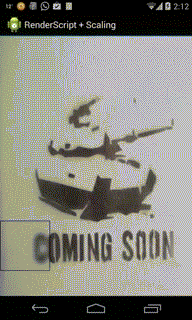
I/(12690): Total time taken: 4
I/(12690): Total time taken: 20
I/(12690): Total time taken: 4
I/(12690): Total time taken: 4
I/(12690): Total time taken: 5
I/(12690): Total time taken: 5
I/(12690): Total time taken: 4
I/(12690): Total time taken: 21
I/(12690): Total time taken: 3
I/(12690): Total time taken: 4
Average => ~ 7.4 ms => 135 drawables per second
Tests carried out on Nex4. Bitmap size - 200px x 200px
Another tip: methods buildDrawingCache() and getDrawingCache() themselves take a long time. An alternative to this is to create a Bitmap using the dimensions of the view you need to blur:
Bitmap toDrawOn = Bitmap.createBitmap(viewWidth, viewHeight, Bitmap.Config.ARGB_8888);
// Create a canvas - assign `toDrawOn` as an offscreen bitmap to it
Canvas holdingCanvas = new Canvas(toDrawOn);
// Now, let the view draw itself on this canvas
yourView.draw(holdingCanvas);
The view is now drawn on toDrawOn and you can use it however you please.
This, in my experience is much faster than generating and accessing a view's drawing cache.
If you need help implementing any of the 4 methods listed above, let me know in comments.
Do keep in mind that the gifs above have been downscaled and whatnot. If you'd like to see original screen-capture (mp4) files - check this Link.
This was on my mind for some time, and I just implemented it thanks to your question.
To be able to do this, we need to draw the layout that is beneath our blur layout into a bitmap. Than by using a blurring algorithm, we need to blur that bitmap and finally draw blurred bitmap as our blur layout's background.
Luckily android has cached drawing mechanism, so first part is easy. We can simply enable cached drawing for our beneath layout and use getDrawingCache() to acquire the bitmap from it.
Now we need a fast blurring algorithm. I used this https://stackoverflow.com/a/10028267/3133545
Here it is.
import android.graphics.Bitmap;
import android.graphics.Canvas;
import android.graphics.ColorFilter;
import android.graphics.Paint;
import android.graphics.PixelFormat;
import android.graphics.drawable.Drawable;
import android.util.Log;
import android.view.View;
import java.lang.ref.WeakReference;
import java.util.InputMismatchException;
/**
* A drawable that draws the target view as blurred using fast blur
* <p/>
* <p/>
* TODO:we might use setBounds() to draw only part a of the target view
* <p/>
* Created by 10uR on 24.5.2014.
*/
public class BlurDrawable extends Drawable {
private WeakReference<View> targetRef;
private Bitmap blurred;
private Paint paint;
private int radius;
public BlurDrawable(View target) {
this(target, 10);
}
public BlurDrawable(View target, int radius) {
this.targetRef = new WeakReference<View>(target);
setRadius(radius);
target.setDrawingCacheEnabled(true);
target.setDrawingCacheQuality(View.DRAWING_CACHE_QUALITY_AUTO);
paint = new Paint();
paint.setAntiAlias(true);
paint.setFilterBitmap(true);
}
@Override
public void draw(Canvas canvas) {
if (blurred == null) {
View target = targetRef.get();
if (target != null) {
Bitmap bitmap = target.getDrawingCache(true);
if (bitmap == null) return;
blurred = fastBlur(bitmap, radius);
}
}
if (blurred != null && !blurred.isRecycled())
canvas.drawBitmap(blurred, 0, 0, paint);
}
/**
* Set the bluring radius that will be applied to target view's bitmap
*
* @param radius should be 0-100
*/
public void setRadius(int radius) {
if (radius < 0 || radius > 100)
throw new InputMismatchException("Radius must be 0 <= radius <= 100 !");
this.radius = radius;
if (blurred != null) {
blurred.recycle();
blurred = null;
}
invalidateSelf();
}
public int getRadius() {
return radius;
}
@Override
public void setAlpha(int alpha) {
}
@Override
public void setColorFilter(ColorFilter cf) {
}
@Override
public int getOpacity() {
return PixelFormat.TRANSLUCENT;
}
/**
* from https://stackoverflow.com/a/10028267/3133545
* <p/>
* <p/>
* <p/>
* Stack Blur v1.0 from
* http://www.quasimondo.com/StackBlurForCanvas/StackBlurDemo.html
* <p/>
* Java Author: Mario Klingemann <mario at quasimondo.com>
* http://incubator.quasimondo.com
* created Feburary 29, 2004
* Android port : Yahel Bouaziz <yahel at kayenko.com>
* http://www.kayenko.com
* ported april 5th, 2012
* <p/>
* This is a compromise between Gaussian Blur and Box blur
* It creates much better looking blurs than Box Blur, but is
* 7x faster than my Gaussian Blur implementation.
* <p/>
* I called it Stack Blur because this describes best how this
* filter works internally: it creates a kind of moving stack
* of colors whilst scanning through the image. Thereby it
* just has to add one new block of color to the right side
* of the stack and remove the leftmost color. The remaining
* colors on the topmost layer of the stack are either added on
* or reduced by one, depending on if they are on the right or
* on the left side of the stack.
* <p/>
* If you are using this algorithm in your code please add
* the following line:
* <p/>
* Stack Blur Algorithm by Mario Klingemann <[email protected]>
*/
private static Bitmap fastBlur(Bitmap sentBitmap, int radius) {
Bitmap bitmap = sentBitmap.copy(sentBitmap.getConfig(), true);
if (radius < 1) {
return (null);
}
int w = bitmap.getWidth();
int h = bitmap.getHeight();
int[] pix = new int[w * h];
Log.e("pix", w + " " + h + " " + pix.length);
bitmap.getPixels(pix, 0, w, 0, 0, w, h);
int wm = w - 1;
int hm = h - 1;
int wh = w * h;
int div = radius + radius + 1;
int r[] = new int[wh];
int g[] = new int[wh];
int b[] = new int[wh];
int rsum, gsum, bsum, x, y, i, p, yp, yi, yw;
int vmin[] = new int[Math.max(w, h)];
int divsum = (div + 1) >> 1;
divsum *= divsum;
int dv[] = new int[256 * divsum];
for (i = 0; i < 256 * divsum; i++) {
dv[i] = (i / divsum);
}
yw = yi = 0;
int[][] stack = new int[div][3];
int stackpointer;
int stackstart;
int[] sir;
int rbs;
int r1 = radius + 1;
int routsum, goutsum, boutsum;
int rinsum, ginsum, binsum;
for (y = 0; y < h; y++) {
rinsum = ginsum = binsum = routsum = goutsum = boutsum = rsum = gsum = bsum = 0;
for (i = -radius; i <= radius; i++) {
p = pix[yi + Math.min(wm, Math.max(i, 0))];
sir = stack[i + radius];
sir[0] = (p & 0xff0000) >> 16;
sir[1] = (p & 0x00ff00) >> 8;
sir[2] = (p & 0x0000ff);
rbs = r1 - Math.abs(i);
rsum += sir[0] * rbs;
gsum += sir[1] * rbs;
bsum += sir[2] * rbs;
if (i > 0) {
rinsum += sir[0];
ginsum += sir[1];
binsum += sir[2];
} else {
routsum += sir[0];
goutsum += sir[1];
boutsum += sir[2];
}
}
stackpointer = radius;
for (x = 0; x < w; x++) {
r[yi] = dv[rsum];
g[yi] = dv[gsum];
b[yi] = dv[bsum];
rsum -= routsum;
gsum -= goutsum;
bsum -= boutsum;
stackstart = stackpointer - radius + div;
sir = stack[stackstart % div];
routsum -= sir[0];
goutsum -= sir[1];
boutsum -= sir[2];
if (y == 0) {
vmin[x] = Math.min(x + radius + 1, wm);
}
p = pix[yw + vmin[x]];
sir[0] = (p & 0xff0000) >> 16;
sir[1] = (p & 0x00ff00) >> 8;
sir[2] = (p & 0x0000ff);
rinsum += sir[0];
ginsum += sir[1];
binsum += sir[2];
rsum += rinsum;
gsum += ginsum;
bsum += binsum;
stackpointer = (stackpointer + 1) % div;
sir = stack[(stackpointer) % div];
routsum += sir[0];
goutsum += sir[1];
boutsum += sir[2];
rinsum -= sir[0];
ginsum -= sir[1];
binsum -= sir[2];
yi++;
}
yw += w;
}
for (x = 0; x < w; x++) {
rinsum = ginsum = binsum = routsum = goutsum = boutsum = rsum = gsum = bsum = 0;
yp = -radius * w;
for (i = -radius; i <= radius; i++) {
yi = Math.max(0, yp) + x;
sir = stack[i + radius];
sir[0] = r[yi];
sir[1] = g[yi];
sir[2] = b[yi];
rbs = r1 - Math.abs(i);
rsum += r[yi] * rbs;
gsum += g[yi] * rbs;
bsum += b[yi] * rbs;
if (i > 0) {
rinsum += sir[0];
ginsum += sir[1];
binsum += sir[2];
} else {
routsum += sir[0];
goutsum += sir[1];
boutsum += sir[2];
}
if (i < hm) {
yp += w;
}
}
yi = x;
stackpointer = radius;
for (y = 0; y < h; y++) {
// Preserve alpha channel: ( 0xff000000 & pix[yi] )
pix[yi] = (0xff000000 & pix[yi]) | (dv[rsum] << 16) | (dv[gsum] << 8) | dv[bsum];
rsum -= routsum;
gsum -= goutsum;
bsum -= boutsum;
stackstart = stackpointer - radius + div;
sir = stack[stackstart % div];
routsum -= sir[0];
goutsum -= sir[1];
boutsum -= sir[2];
if (x == 0) {
vmin[y] = Math.min(y + r1, hm) * w;
}
p = x + vmin[y];
sir[0] = r[p];
sir[1] = g[p];
sir[2] = b[p];
rinsum += sir[0];
ginsum += sir[1];
binsum += sir[2];
rsum += rinsum;
gsum += ginsum;
bsum += binsum;
stackpointer = (stackpointer + 1) % div;
sir = stack[stackpointer];
routsum += sir[0];
goutsum += sir[1];
boutsum += sir[2];
rinsum -= sir[0];
ginsum -= sir[1];
binsum -= sir[2];
yi += w;
}
}
bitmap.setPixels(pix, 0, w, 0, 0, w, h);
return (bitmap);
}
}
Usage :
View beneathView = //the view that beneath blur view
View blurView= //blur View
BlurDrawable blurDrawable = new BlurDrawable(beneathView, radius);
blurView.setBackgroundDrawable(blurDrawable);
And how my test application looked like:
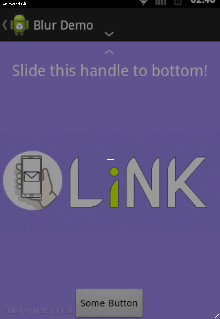
I decided not to use this tho, because it is too hacky and not looking as cool as i thought it would be in first place.
Here is a good way to "Blur Images Efficiently using Renderscript" by GDE Mario Viviani.
Here is the copy/paste:
Blurring images is an effect a lot of developers need to achieve, and it may require some time and efforts to be implemented. Also, since a lot of image manipulation is required, if it's not appropriately coded it can be really a pain in terms of CPU and memory usage.
There's a quick and efficient solution to blur images, which is Renderscript.
Available since API 11 (Honeycomb), Renderscript allows to take advantage of the GPU acceleration and is targeted at high-performance 3D rendering and compute operations.
Renderscript is a really complex and articulated product, and allows deep configuration and coding using native C99 language, which allows portability, performance and usability.
However, since API 17 (4.2.2) Renderscript offer some built-in functions that perform well-defined operations, called Intrinsics.
Intrinsics are pre-written scripts that allow, to perform operations like Blur, Blen, Matrix Convolution and more, without the need to write Renderscript code.
Here's a simple method I wrote to easily end efficiently apply a Blur filter to a Bitmap:
public Bitmap blurBitmap(Bitmap bitmap) {
//Let's create an empty bitmap with the same size of the bitmap we want to blur
Bitmap outBitmap = Bitmap.createBitmap(bitmap.getWidth(), bitmap.getHeight(), Config.ARGB_8888);
//Instantiate a new Renderscript
RenderScript rs = RenderScript.create(getApplicationContext());
//Create an Intrinsic Blur Script using the Renderscript
ScriptIntrinsicBlur blurScript = ScriptIntrinsicBlur.create(rs, Element.U8_4(rs));
//Create the in/out Allocations with the Renderscript and the in/out bitmaps
Allocation allIn = Allocation.createFromBitmap(rs, bitmap);
Allocation allOut = Allocation.createFromBitmap(rs, outBitmap);
//Set the radius of the blur
blurScript.setRadius(25.f);
//Perform the Renderscript
blurScript.setInput(allIn);
blurScript.forEach(allOut);
//Copy the final bitmap created by the out Allocation to the outBitmap
allOut.copyTo(outBitmap);
//recycle the original bitmap
bitmap.recycle();
//After finishing everything, we destroy the Renderscript.
rs.destroy();
return outBitmap;
}

And...voilà! Blurred bitmap! :-)
Remember that to run the previous code you need minimum API 17 (4.2.2).
Here's a Gist of this method: https://gist.github.com/Mariuxtheone/903c35b4927c0df18cf8
If you want to discover more about Intrinsics, check out this post on Android Developers Blog: http://android-developers.blogspot.it/2013/08/renderscript-intrinsics.html
If you're interested in know more about Renderscript, check out these links: http://android-developers.blogspot.it/2011/02/introducing-renderscript.html http://android-developers.blogspot.it/2011/03/renderscript.html